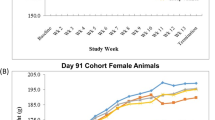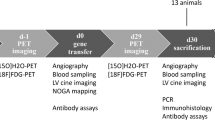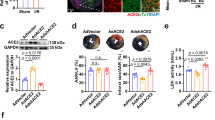Abstract
Sequestration of tumor necrosis factor-α (TNFα) by TNF-receptor immunoglobulin G (IgG)-Fc fusion proteins can limit heart failure progression in rodent models. In this study we directly injected an adeno-associated viruses (AAV)-2 construct encoding a human TNF receptor II IgG-Fc fusion protein (AAV-TNFRII-Fc) into healthy baboon hearts and assessed virally encoded gene expression and clinical response. Adult baboons received direct cardiac injections of AAV-TNFRII-Fc (∼5 × 1012 viral/genomes/baboon) or an equivalent dose of AAV-2 empty capsids, and were analyzed after 5 or 12 weeks. Viral genomes were restricted to the myocardium, and routine analyses (blood cell counts, clinical chemistries) remained unremarkable. Echocardiograms were unchanged but electrocardiograms revealed marked ST- and T-wave changes consistent with myocarditis only in baboons receiving AAV-TNFRII-Fc. TNFRII serum levels peaked at ∼3 times the baseline levels at 1–2 weeks postinjection and subsequently declined to baseline levels. TNFRII-Fc protein and transcripts were detected in the heart at harvest. After AAV injection, anti-AAV-2 antibody levels increased in all baboons, while anti-TNFRII-Fc could not be detected. Baboons that received AAV-TNFRII-Fc developed myocardial infiltrates including CD8+ cells. Thus, a cellular immune response to cardiac delivery of AAV encoding foreign proteins may be an important consideration for AAV-based cardiac gene therapy.
This is a preview of subscription content, access via your institution
Access options
Subscribe to this journal
Receive 12 print issues and online access
$259.00 per year
only $21.58 per issue
Buy this article
- Purchase on Springer Link
- Instant access to full article PDF
Prices may be subject to local taxes which are calculated during checkout








Similar content being viewed by others
References
Torre-Amione G, Kapadia S, Benedict C, Oral H, Young JB, Mann DL . Proinflammatory cytokine levels in patients with depressed left ventricular ejection fraction: a report from the Studies of Left Ventricular Dysfunction (SOLVD). J Am Coll Card 1996; 27: 1201–1206.
Feldman AM, Combes A, Wagner D, Kadakomi T, Kubota T, Li YY et al. The role of tumor necrosis factor in the pathophysiology of heart failure. J Am Coll Card 2000; 35: 537–544.
Kubota T, McTiernan CF, Frye CS, Slawson SE, Lemster BH, Koretsky AP et al. Dilated cardiomyopathy in transgenic mice with cardiac-specific overexpression of tumor necrosis factor-alpha. Circ Res 1997; 81: 627–635.
Li D, Zhao L, Liu M, Du X, Ding W, Zhang J et al. Kinetics of tumor necrosis factor alpha in plasma and the cardioprotective effect of a monoclonal antibody to tumor necrosis factor alpha in acute myocardial infarction. Am Heart J 1999; 137: 1145–1152.
Higuchi Y, McTiernan CF, Frye CB, McGowan BS, Chan TO, Feldman AM . Tumor necrosis factor receptors 1 and 2 differentially regulate survival, cardiac dysfunction, and remodeling in transgenic mice with tumor necrosis factor-alpha-induced cardiomyopathy. Circulation 2004; 109: 1892–1897.
Ramani R, Mathier M, Wang P, Gibson G, Togel S, Dawson J et al. Inhibition of tumor necrosis factor receptor-1-mediated pathways has beneficial effects in a murine model of postischemic remodeling. Am J Physiol 2004; 287: H1369–H1377.
Kubota T, Bounoutas GS, Miyagishima M, Kadokami T, Sanders VJ, Bruton C et al. Soluble tumor necrosis factor receptor abrogates myocardial inflammation but not hypertrophy in cytokine-induced cardiomyopathy. Circulation 2000; 101: 2518–2525.
Sugano M, Koyanagi M, Tsuchida K, Hata T, Makino N . In vivo gene transfer of soluble TNF-alpha receptor 1 alleviates myocardial infarction. FASEB J 2002; 16: 1421–1422.
Moreland LW, Baumgartner SW, Schiff MH, Tindall EA, Fleischmann RM, Weaver AL et al. Treatment of rheumatoid arthritis with a recombinant human tumor necrosis factor receptor (p75)-Fc fusion protein. N Engl J Med 1997; 337: 141–147.
Leonardi CL, Powers JL, Matheson RT, Goffe BS, Zitnik R, Wang A et al. Etanercept as monotherapy in patients with psoriasis. N Engl J Med 2003; 349: 2014–2022.
Mann DL, McMurray JJ, Packer M, Swedberg K, Borer JS, Colucci WS et al. Targeted anticytokine therapy in patients with chronic heart failure: results of the Randomized Etanercept Worldwide Evaluation (RENEWAL). Circulation 2004; 109: 1594–1602.
Su H, Lu R, Kan YW . Adeno-associated viral vector-mediated vascular endothelial growth factor gene transfer induces neovascular formation in ischemic heart. Proc Nat Acad Sci USA 2000; 97: 13801–13806.
Zhu T, Zhou L, Mori S, Wang Z, McTiernan CF, Qiao C et al. Sustained whole-body functional rescue in congestive heart failure and muscular dystrophy hamsters by systemic gene transfer. Circulation 2005; 112: 2650–2659.
Pacak CA, Mah CS, Thattaliyath BD, Conlon TJ, Lewis MA, Cloutier DE et al. Recombinant adeno-associated virus serotype 9 leads to preferential cardiac transduction in vivo. Circ Res 2006; 99: 3–9.
Chirmule N, Xiao W, Truneh A, Schnell MA, Hughes JV, Zoltick P et al. Humoral immunity to adeno-associated virus type 2 vectors following administration to murine and nonhuman primate muscle. J Virol 2000; 74: 2420–2425.
Sandalon Z, Bruckheimer EM, Lustig KH, Burstein H . Long-term suppression of experimental arthritis following intramuscular administration of a pseudotyped AAV2/1-TNFR:Fc vector. Mol Ther 2007; 15: 264–269.
Yu X, Patterson E, Huang S, Garrett MW, Kem DC . Tumor necrosis factor α rapid ventricular tachyarrhythmias, and infarct size in canine models of myocardial infarction. J Cardiovasc Pharmacol 2005; 45: 153–159.
Chirmule N, Propert K, Magosin S, Qian Y, Qian R, Wilson J . Immune responses to adenovirus and adeno-associated virus in humans. Gene Therapy 1999; 6: 1574–1583.
Anderson P, Louie J, Lau A, Broder M . Mechanisms of differential immunogenicity of tumor necrosis factor inhibitors. Curr Rheumatol Rep 2005; 7: 3–9.
Barrier BF, Bates GW, Leland MM, Leach DA, Robinson RD, Propst AM . Efficacy of anti-tumor necrosis factor therapy in the treatment of spontaneous endometriosis in baboons. Fertil Steril 2004; 81 (Suppl 1): 775–779.
Gao G, Lu Y, Calcedo R, Grant RL, Bell P, Wang L et al. Biology of AAV serotype vectors in liver-directed gene transfer to nonhuman primates. Mol Ther 2006; 13: 77–87.
Herzog RW, Fields PA, Arruda VR, Brubaker JO, Armstrong E, McClintock D et al. Influence of vector dose on factor IX-specific T and B cell responses in muscle-directed gene therapy. Hum Gene Ther 2002; 13: 1281–1291.
Nathwani AC, Davidoff A, Hanawa H, Zhou JF, Vanin EF, Nienhuis AW . Factors influencing in vivo transduction by recombinant adeno-associated viral vectors expressing the human factor IX cDNA. Blood 2001; 97: 1258–1265.
Sarukhan A, Soudais C, Danos O, Jooss K . Factors influencing cross-presentation of non-self antigens expressed from recombinant adeno-associated virus vectors. J Gene Med 2001; 3: 260–270.
Wang L, Dobrzynski E, Schlachterman A, Cao O, Herzog RW . Systemic protein delivery by muscle-gene transfer is limited by a local immune response. Blood 2005; 105: 4226–4234.
Manno CS, Pierce GF, Arruda VR, Glader B, Ragni M, Rasko JJ et al. Successful transduction of liver in hemophilia by AAV-Factor IX and limitations imposed by the host immune response. Nat Med 2006; 12: 342–347.
Smith SC, Allen PM . Neutralization of endogenous tumor necrosis factor ameliorates the severity of myosin-induced myocarditis. Circ Res 1992; 70: 856–863.
Yamada T, Matsumori A, Sasayama S . Therapeutic effect of anti-tumor necrosis factor-alpha antibody on the murine model of viral myocarditis induced by encephalomyocarditis virus. Circulation 1994; 89: 846–851.
Korth-Bradley JM, Rubin AS, Hanna RK, Simcoe DK, Lebsack ME . The pharmacokinetics of etanercept in healthy volunteers. Ann Pharm 2000; 34: 161–164.
Kwon HJ, Cote TR, Cuffe MS, Kramer JM, Braun MM . Case reports of heart failure after therapy with a tumor necrosis factor antagonist. Ann Intern Med 2003; 138: 807–811.
Zeltser R, Valle L, Tanck C, Holyst MM, Ritchlin C, Gaspari AA . Clinical, histological, and immunophenotypic characteristics of injection site reactions associated with etanercept: a recombinant tumor necrosis factor alpha receptor: Fc fusion protein. Arch Derm 2001; 137: 893–899.
Herzog RW . Immune responses to AAV capsid: are mice not humans after all? Mol Ther 2007; 15: 649–650.
Jacobs CA, Smith CA . Methods of lowering active TNF-alpha levels in mammals using tumor necrosis factor receptor. US Patent 5: 605–690, US Patent and Trademark Office, Washington DC, 1997.
Xiao X, Li J, Samulski RJ . Production of high-titer recombinant adeno-associated virus vectors in the absence of helper adenovirus. J Virol 1998; 72: 2224–2232.
Acknowledgements
We thank Bonnie Lemster, Tjendimin Tjandrawan, Jennifer Rager, David Meleason and Michael Murphey-Corb for their contributions in animal procedures and analyses, and Paul Robbins for plasmids encoding TNFRII-Fc. The work was supported by NIH grant U01HL66949.
Author information
Authors and Affiliations
Corresponding author
Additional information
Supplementary Information accompanies the paper on Gene Therapy website (http://www.nature.com/gt)
Supplementary information
Rights and permissions
About this article
Cite this article
McTiernan, C., Mathier, M., Zhu, X. et al. Myocarditis following adeno-associated viral gene expression of human soluble TNF receptor (TNFRII-Fc) in baboon hearts. Gene Ther 14, 1613–1622 (2007). https://doi.org/10.1038/sj.gt.3303020
Received:
Revised:
Accepted:
Published:
Issue Date:
DOI: https://doi.org/10.1038/sj.gt.3303020
Keywords
This article is cited by
-
Promise of adeno-associated virus as a gene therapy vector for cardiovascular diseases
Heart Failure Reviews (2017)
-
DNA delivery to ‘ex vivo’ human liver segments
Gene Therapy (2012)
-
Cardiac gene therapy in large animals: bridge from bench to bedside
Gene Therapy (2012)
-
AAV Vectors for Cardiac Gene Transfer: Experimental Tools and Clinical Opportunities
Molecular Therapy (2011)
-
Percutaneous Transendocardial Delivery of Self-complementary Adeno-associated Virus 6 Achieves Global Cardiac Gene Transfer in Canines
Molecular Therapy (2008)



